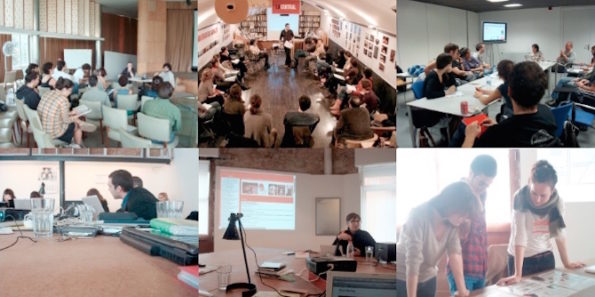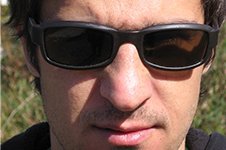Search
To search for an exact match, type the word or phrase you want in quotation marks.
A*DESK has been offering since 2002 contents about criticism and contemporary art. A*DESK has become consolidated thanks to all those who have believed in the project, all those who have followed us, debating, participating and collaborating. Many people have collaborated with A*DESK, and continue to do so. Their efforts, knowledge and belief in the project are what make it grow internationally. At A*DESK we have also generated work for over one hundred professionals in culture, from small collaborations with reviews and classes, to more prolonged and intense collaborations.
At A*DESK we believe in the need for free and universal access to culture and knowledge. We want to carry on being independent, remaining open to more ideas and opinions. If you believe in A*DESK, we need your backing to be able to continue. You can now participate in the project by supporting it. You can choose how much you want to contribute to the project.
You can decide how much you want to bring to the project.

There was a time at the beginning of the last decade when the idea of the exhibition as a place for art was widely debated and contested. To do exhibitions or not to do them; this seemed to be the dilemma for artists seduced by the possibilities of the “project” and curators interested in reformulating the critical legacy of conceptual art. But the exhibition didn’t die; it is still the main channel for the visualization of art. However, who would have predicted the rise of the idea of the workshop as a format for the expression and communication of art? There is no self-respecting institution or museum that doesn’t programme them. There is no exhibition without parallel workshops. No news appears on the mailing list of Art & Education without the word workshop. Yes, because workshop also means studio, although the Castilian understanding of the word has a taste of industry and manufacture that on many occasions is no longer applicable. A workshop can be, nonetheless, a catchall term for almost anything. And also a good MacGuffin, a transitional object that mobilises and channels intentions that are not entirely clear. A space for production. Why not?
A short history of workshops in the Spanish state remits us to the non-regulated and post-academy educational programmes that emerged in parallel to the institutionalisation and structuring of museums during the eighties and nineties. Amongst the most outstanding one would have to refer to the courses of Arteleku in San Sebastián; the workshops in Arte Actual in Madrid; and the most veteran, dating from the end of the seventies, namely the Quinzena d’Art de Montesquiu (QUAM) that were developed at different points and places of the Catalan territory in various stages and organisational forms. These were followed by Hanger in Barcelona, which opened in 1997 as an initiative of the Associació d’artistes visuals de Catalunya (AAVC) with the aim of responding to a need arising from the lack of spaces dedicated to completing the training of new generations of artists. The centre Bilbaoarte opened in 1998 as well as others, like the more recent space La Térmica in Malaga, to mention just a few.
What arose from these workshops was the possibility for a shared space for the understanding and experience of art. To compare and contrast knowledge and opinions, a space in which to encounter artists and forge friendships. To bring together artists from different generations, critics, and thinkers. At the start these workshops were almost all practical, led by artists with sufficient stature to attract a large number of participants. The duration could oscillate between fifteen days and various months, but the standard format was more or less a month. With the passing of time forums were incorporated with talks by international experts (this was how the QUAM, for example, was organised since 2001, where a space for reflection, the Fòrum QUAM, was established in parallel with the workshops, along with a platform for the presentation of projects). The type of workshop revolved around the exceptionality of the event itself, a slowing of the time of reflection and production, the configuration of a temporarily autonomous zone situated between the university, the school, and the (often grim) reality of the professional system; a space where one could become an artist. This expanded and generous temporality meant an artist could realize several, a few, workshops, fulfilling in this way a formative cycle, passing the baton on to new generations. The people “hooked” on the dynamics of doing workshops or tallers were called talleristas.
With minimal historical perspective, it can be said that this situation has now become inverted and that the current generation of artists are obliged to become talleristas, they have no alternative. The state of exception of the workshop format has mutated into an overwhelming surfeit of micro-workshops, micro-seminars, and a wide range of possibilities with which to carve out an academic curriculum of masters and PhDs. The completion and structuring of the museums and institutions have generated a new, expanded threshold for permanent education – in tune with the endlessly repeated diagnostic of the new younger generations that don’t manage to gain access to the labour market; which is, over-qualification. Art here follows the gravitational logic of other social and economic dynamics such as the academy and the university; this new factory we never manage to leave. The refrain, that we are never sufficiently prepared, the rush to sign up for a new course. The consideration of training as “temporal” or provisional has extended to encompass a lifetime. With workshops that last, for example, a day or an afternoon, a young artist can, in a year, amass a lengthy CV with which to solicit a grant. It is not surprising therefore that in CVs the list of workshops and surplus of names way surpasses in length the individual or group exhibitions realised.
What type of artist arises from this new configuration of artistic education? What about those who want to learn a manual technique, etching, screen-printing, or sculpture? To ask where and in what state the workshops find themselves in and their availability and accessibility doesn’t suppose a yearning for any discipline so much as the questioning of by whom and how these means of production are controlled, whether they are public or private, and other material considerations surrounding artistic production. The increasing relevance granted to the cognitive in the work of art doesn’t eclipse the experiential, speculative character of a work of art. In response to these considerations about the state of artistic education, last year some artists set in motion an experimental project of a school in San Sebastian, Kalostra, taking up the baton of the workshops of the now disappeared Arteleku, although the Diputación de Gipuzkoa has cancelled said project (after less than a year’s duration) due to a supposed simultaneity and overlapping with the recently inaugurated centre Tabakalera.
It ends up being impossible in this evolution to obviate the developments incorporated with the emergence of the figure of the curator: the “curating” of education and the inflation of “mediation”. The “educational turn” can be summed up as the vision dispatched by the institutional structures, through the curating of education, as a model of relations and production useful for artists. But some of these initiatives of this “educational turn” have been more preoccupied with “discursifying” education (or curating it) than in offering real, alternative practices, which on occasions has led to a folding in on itself. The “educational turn” is, therefore, more rhetorical than strictly speaking a space for education; each fold leads implicitly to a degree of tautology and self-referencing. For example, a workshop “about” the idea of the workshop? No, it’s not fictional. These days in March the Fondazione Antonio Ratti in Como (Italy), is offering to the public the program Workshop on Workshops, a symposium more than, hélas, a workshop! The intentions of this programme consist of “ focus on discussing post-academic research within artistic practice in the context of residencies, workshops and alternative educational practice”. A clear case of the “educational turn”.
But what hasn’t changed and remains an unalterable truth, before and after, is the maxim of John Andrew Rice, the founder of the legendary Black Mountain College in 1933. Students can be educated for freedom only by teachers who are themselves free. This is the first and fundamental principal. Next, let the workshops begin.

Peio Aguirre writes about art, film, music, theory, architecture and politics, amongst other subjects. The genres he works in are the essay and meta-commentary, a hybrid space that fuses disciplines on a higher level of interpretation. He also (occasionally) curates and performs other tasks. He writes on the blog “Crítica y metacomentario” (Criticism and metacommentary).
"A desk is a dangerous place from which to watch the world" (John Le Carré)